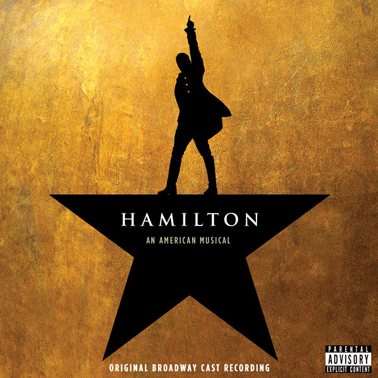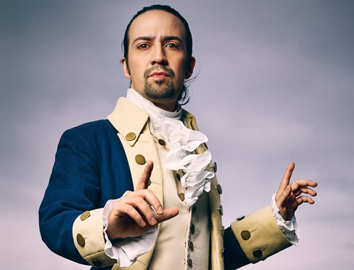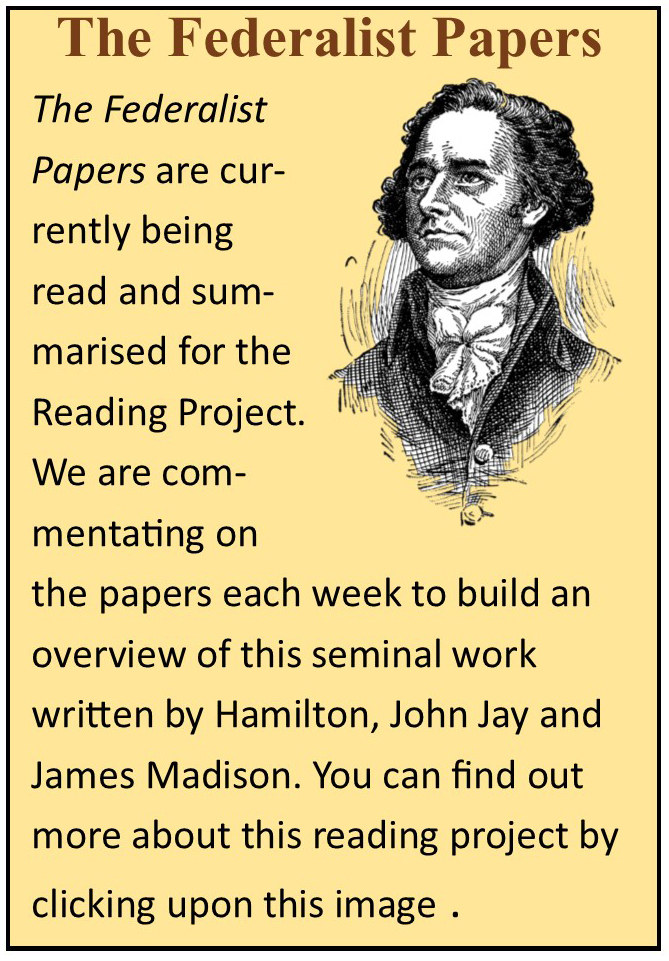

- Category:Biography, Non-Fiction
- Date Read:15 November 2017
- Pages:731 (Text) 818 (including acknowledgements, bibliography and index)
- Published:2004
- Prize:George Washington Book Prize 2005

On July 11, 1804, America’s first Treasury Secretary, Alexander Hamilton, faced the vice-President of the United States of America, Aaron Burr, across a duelling ground in New Jersey and was shot. The bullet broke a rib, went right through his liver and lodged in his spine. Afterwards he was unable to feel his legs. He was taken to the house of a friend, William Bayard, where he was to die the next day.
The event beggars belief. Hamilton was George Washington’s right-hand man in the War of Independence against Britain. He helped shape the American Constitution at the Constitutional Convention, almost singlehandedly shaped America’s banking and financial institutions, for which America owes much of its prosperity, defended the constitution as the main writer of the Federalist Papers, engaged in many varied public works and other political endeavours and was a leading lawyer in New York during the early years of the new nation. He was an early abolitionist for slavery. He was considered one of America’s most influential founding fathers. At the same time, he was also one of America’s most controversial political figures. He inspired political envy and was the subject of character assassinations from the likes of Jefferson and Maddison, both future presidents. He also destroyed his own personal reputation to clear his professional name. When accused of financial malfeasance as Treasury Secretary he publicly revealed that the money in question had no political connection, but had been paid to the husband of his lover, Maria Reynolds, to keep the affair quiet. Yet despite all this, he was considered by many of his day as one of the greatest and most influential political thinkers and writers of his age.
Burr, by contrast, despite having achieved the vice-Presidency, was virtually shunned by Jefferson, his president. He was not trusted. He left few writings of a political nature. Much of his writing is of a personal, even salacious tone. He was a political animal but appears to have had few strong commitments to policy. His final quarrel with Hamilton was a perceived interference in his ambitions, the catalyst of which was a reported dinner conversation some three month prior to his challenge. Burr’s actions, given his station and Hamilton’s record, seem incredible to our modern point of view. Yet regardless of two courts that pressed for murder charges against Burr, Burr never went to gaol. He was exculpated by the traditions of gentlemanly duelling.
The duel and how Hamilton died is probably the most memorable circumstance of Hamilton’s life, and Lin-Manuel Miranda, the creator of the hit musical based upon Ron Chernow’s biography, used it to great dramatic effect, with the final drama heightened by a duel in the first act involving the incompetent General Lee, and then the death of Hamilton’s first son, Philip, in the second act in a duel over a matter of honour concerning Hamilton’s reputation. Miranda’s musical focuses on the revolutionary years in the first act. The second act mostly concerns the political infighting between Federalist and Republican politicians over matters of finance and identity – where would the new capitol be established? for instance – leading up to Hamilton’s disgrace over Maria Reynolds, his political obscurity during the Adams administration and the ever-present Burr who becomes increasingly frustrated by Hamilton’s brilliance and his own failure.
My edition of Chernow’s book advertises its link with the musical – The inspiration for the award winning musical
– on the front cover. Miranda’s musical, with its mixture of hip-hop and other traditional theatre musical styles, is certainly extraordinary, having won the Pulitzer Prize and 11 Tony Awards, including for Best Musical. It takes a complex story from a book with over 700 dense pages, a source one would intuitively think is unsuitable for musical theatre, and creates a moving tribute to the ideals of the American Revolution as well as an interesting portrait of the protagonists, Hamilton and Burr, as well as other key figures of the period like Thomas Jefferson.
My interest in the book came from the musical, which is why I mention it here. I cannot separate my reading of the book from my first impressions created by the musical. The fact is, I had never heard of Alexander Hamilton before my son began to play me some of the songs. As the first song suggests: His enemies destroyed his rep America forgot him
. As an Australian I had a broad understanding of the importance of America’s revolution and knew some basic facts about key players - Washington, of course, even Jefferson, Maddison and Adams - but I had never formally studied it or read much about it. After my son introduced me to the musical I became interested and started listening to it in its entirety during my frequent walks.
The thing about Chernow’s book for anyone coming to the subject from the musical, is that it will take some commitment. The book is extremely long and dense. It was written as a political biography, not as an adjunct to the musical. It came first. Chernow’s account is detailed and scholarly. However, it is also highly readable. The book is divided into relatively short chapters, often twenty to thirty pages long, although sometimes shorter. Chernow is also aware that he is telling a story and that his subject is incredibly interesting. He does great justice to Hamilton’s life. And this is not because Chernow’s work is a hagiographic account. Rather, Chernow is analytical and even-handed. He has much to criticise Hamilton for, whether it be for poorly considered proposals at the Constitutional Convention for which his enemies vilified him for the rest of his life, his naïve involvement with Maria Reynolds and his own subsequent public revelation of the affair, to his temperamental personality and his inability to appeal to common people on an intellectual level, to poor political choices he made late in his career. Whenever Hamilton mis-steps, Chernow is willing to acknowledge it and analyse his faults and the impact they had on Hamilton and those around him.
But what makes Hamilton a worthy subject of a biography is not just that he was influential, but that he was a brilliant man. Orphaned as a child and living in poverty on a Carribean island, he made his way to America to become one of the most powerful and influential people in all American history. His is the quintessential story of the old American dream. What also justifies the biography is that Hamilton died much younger than many of his political contemporaries, and his memory and achievement was demeaned, attacked and degraded by those who got to write history; those who weren’t shot and killed in New Jersey in 1804. His wife, Eliza, spent much of the rest of her life (she survived him by half a century) gathering documents and remembrances for a biography and his fourth son, John Church Hamilton, spent decades writing an account, but Hamilton’s reputation slipped into obscurity, nevertheless. This happened even though his state funeral attests to the importance his contemporaries placed upon his life and achievement. It is said to have been the largest in American History.
For those whose interest, like mine, is piqued by the musical, there is also a lot that is interesting in the book, for its own sake. As I first started to read I was interested in identifying moments that are dramatized by Miranda. Of particular interest was seeing how Miranda drew phrases directly from the book to furnish his own lyric. For instance, Burr sings in his final song after Hamilton’s death I should have known the world was wide enough for Hamilton and me.
The line is taken from a remark Burr was said to have made, possibly the only evidence of contrition available, according to Chernow. The song, ‘Best of Wives and Best of Women’ is lifted from Hamilton’s closing statements in a note he left for his wife on the morning of the duel. There are many other phrases or scenes that find their equivalent in the musical.
While the musical is dense and detailed, it was never going to be possible to include all the detail from Chernow’s book. So, I found the book interesting in the way it clarified moments in the musical, or how it filled in gaps. The period after the revolution is not so detailed in Miranda’s adaptation and the book provides many incidents from this period that are not used at all, and other examples where more detail and insight is provided. For instance, in the song in which Hamilton is asked whom he would prefer for president, Jefferson or Burr (both men having been rivals of Hamilton in one fashion or another for years), Hamilton declares support for Jefferson on the basis that Burr has no guiding principles or beliefs. This is a recurring argument throughout the musical. But what was not so clear to me was why the choice was between Jefferson or Burr, both running as Republicans against the Federalist incumbent, John Adams. Chernow recounts how Adams was knocked out of the race, but Burr and Jefferson garnered the same number of electoral votes. Burr should have stepped aside for Jefferson, given that he was the acknowledged vice-Presidential candidate, but he went quiet and allowed five days of political turmoil to ensue as the Republicans tried to separate the two candidates in over thirty-five votes. His vaulting ambition and lack of loyalty were prime reasons why Jefferson snubbed him in office and why his political fortunes failed, which thereafter became a factor in his eventual challenge of Hamilton.
There are other dramatic incidents the book relates that would have just slowed the musical. For instance, the wide-scale resistance to a tax on whisky which led to a full-scale rebellion. At one point the building in which the Constitutional Conventionalists were working was surrounded by an angry mob. They were forced to escape. It’s incredible to think that some of the foremost minds framing the terms of the new nation, including Hamilton, may have been killed in an incident like that.
Apart from the many revealing episodes like this, the book is also fascinating (from the perspective of the musical fan) for the creative choices it reveals that Miranda made. For instance, when Hamilton meets the Schuyler sisters in the musical, he first catches Angelica’s eye. Angelica, upon seeing that her sister, Eliza, is smitten with Hamilton, nobally steps aside. However, the reality is that Angelica was already married to John Church and spent many years living with him in England. Peggy, the third sister, is briefly introduced in the musical but seems to fade from the drama. Miranda doesn’t cover her early death.
The book also provides a long perspective on history. Hamilton believed in a central government, and argued that it was necessary to address debt accrued from the war against England. It is interesting to see the seeds of the Civil War of the 1860s sown in the very beginnings of the republic. Many southerners believed that a centralised government would make them responsible for a debt they didn’t hold. Tied to these arguments was the thorny issue of slavery which was integral to the southern economy. Northern states began to abandon slavery early in the union, and this was an issue that divided northern and southern states. Despite this, the early presidents all held slaves. Of the early presidents, only Washington freed his slaves upon his death. Hamilton was a staunch abolitionist.
But one of the most fascinating revelations the book provided was on the character of Burr. Burr is the villain of Miranda’s musical, but Miranda softens him for his audience. After Hamilton’s death he expresses regret – the world was wide enough
– and Miranda uses Burr’s daughter, Theodosia, to elicit sympathy for him. In fact, Hamilton and Burr share a song in which they talk of their love for their children. When Burr speaks to the audience about the duel he is allowed to emphasise Hamilton’s use of his glasses, If not to take deadly aim?
and is fearful his daughter will be left an orphan. The fact is, as Chernow shows, Theodosia was a grown woman and already married when Burr challenged Hamilton. His wife had died several years before. Hamilton, in contrast, was married with a great deal of debt and had seven children. His eldest daughter, Angelica, had suffered a complete mental breakdown after the death of her brother, Philip, in his duel, and never recovered. This poignant detail is neglected by the musical. Miranda also has Burr point out that Hamilton was an expert shot. As for himself, Miranda has him say, My fellow soldiers’ll tell you I’m a terrible shot.
In contrast, Chernow gives evidence that Burr was an excellent shot and had in fact been engaging in target practice for up to three months before the duel. Hamilton hadn’t fired a weapon since the war and refused to practise. He made it clear to everyone that he intended to fire away from Burr; to waste his shot. Burr, the vice-President of the United States of America, later had two murder convictions brought against him. He fled to Philadelphia and later to Europe and eventually returned to America in 1812 after the charges had been dropped. There is almost nothing redeeming about the portrait Chernow paints of Burr, which is an interesting contrast to the portrait painted by Miranda.
Of course, there would be many interested in the story of Hamilton and his contribution to the modern world who have no interest in the musical. The musical has not arrived in Australia yet [I have seen it on Disney+ and a live production in Sydney since writing this review - June 2021] and I find that many people have still not heard of the musical or Hamilton. Naturally, the book does not require any knowledge of it, but I found it an interesting perspective from which to approach Chernow’s account.
There are so many fascinating details in this book which no review could cover. The book is a weighty tome, but I think it is succinct and very readable. Chernow has a talent for shaping Hamilton’s busy and influential life and distilling this complex personality. For instance, he says of Hamilton:
Alexander Hamilton triumphed as a doer and thinker, not as a leader of the average voter. He was simply too unashamedly brainy to appeal to the masses. (627)
I think that’s a pretty good summation.
The book comes with an excellent index and bibliography which could be useful for those studying this period seriously. There is a middle section in the book with black and white photographs of portraits of the key figures from the biography, including a picture of Hamilton’s house, the Grange, which he completed before his death and for which he indebted his family. Chernow’s narrative is also interspersed with quotes from some of the key figures of the story, particularly Hamilton, who was a prolific writer.
Overall, despite the character failings that Chernow acknowledges, the final verdict on Hamilton appears to be that he was a great man. One of the strengths of the book is that it so ably answers many of the criticisms made of Hamilton repeatedly through his life, despite overwhelming evidence to show they were not true, and criticisms made about him after his death. Hamilton was a brilliant, mercurial man and it is easy to see that he would be misunderstood by many of his contemporaries, or that his intellect would be threatening. Chernow weighs the criticisms with evidence throughout. While I have read nothing else about him, I would surmise, based on the evidence presented, that Chernow’s book is a more even-handed and accurate portrait than past biographies.
I would highly recommend this book. It took me a couple of months to read – I’ve also been reading and reviewing other books on this site since I started – but I found it easy to pick up and continue, even after a break. I found myself discussing aspects of the book with my son and others. It’s well worth the time and effort.
The Musical




No one has commented yet. Be the first!